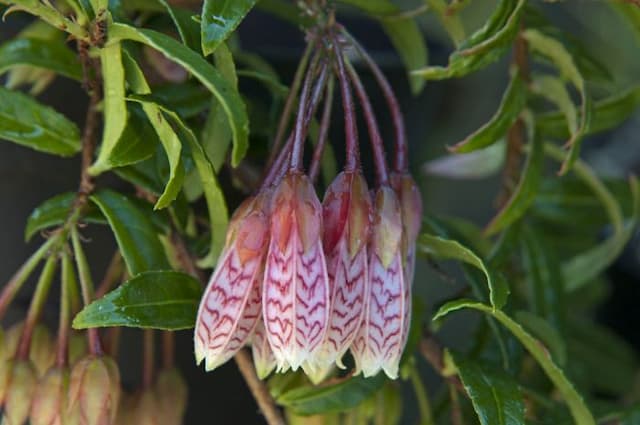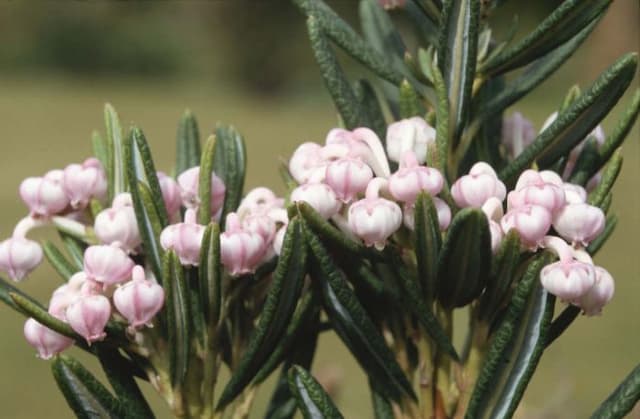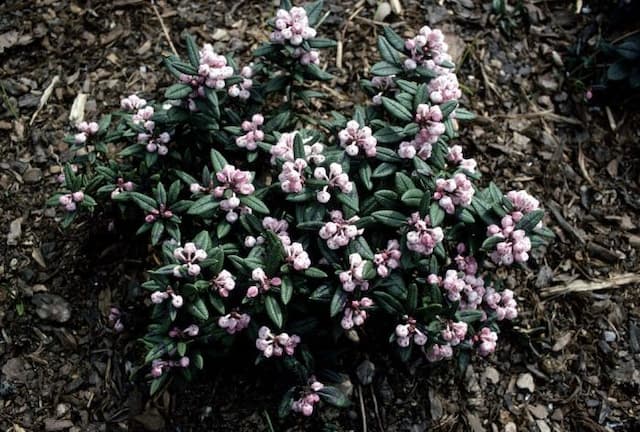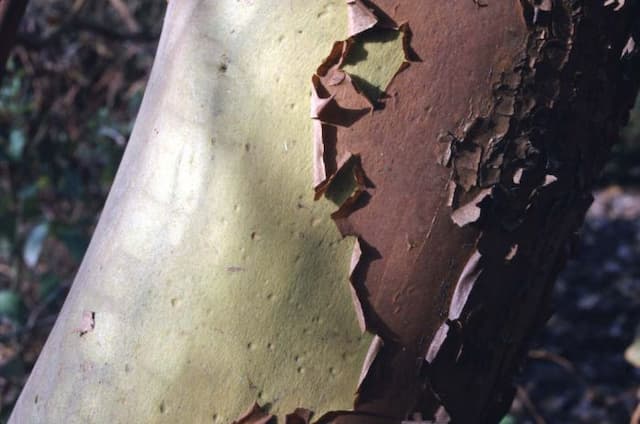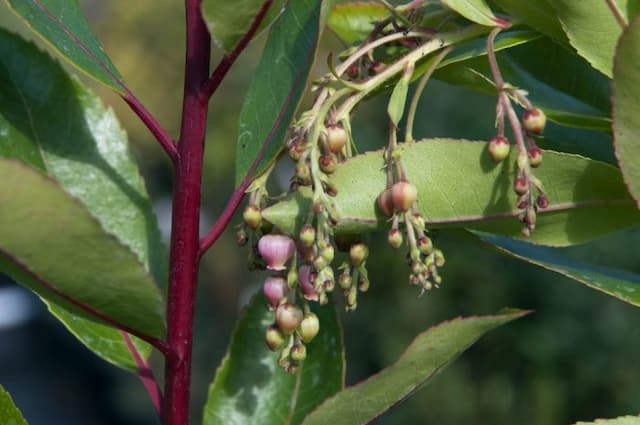Golden Findling Winter Heath Erica carnea f. aureifolia 'Gelber Findling'

ABOUT
The plant known as 'Gelber Findling' is a visually striking variety characterized by its vibrant foliage and petite blossoms. The leaves stand out with a golden-yellow hue, providing a colorful contrast to the greenery typically found in garden settings. This golden-toned foliage often deepens to bronze during the colder months, adding interest to the winter landscape. Spring brings forth an abundance of bell-shaped flowers, which cloak the plant in shades of vibrant pink. The blossoms are small but numerous, creating a dense, textured effect that can add a flush of color to any garden space. The plant's overall appearance is lush and vibrant, with its combination of striking golden foliage and pink floral display, making it a popular choice among gardeners looking to add year-round color to their gardens.
About this plant
 Names
NamesFamily
Ericaceae
Synonyms
Golden Findling Winter Heath, Yellow Winter Heath, Aureifolia Winter Heath
Common names
Erica carnea f. aureifolia 'Gelber Findling'.
 Toxicity
ToxicityTo humans
Winter heath (Erica carnea) is generally considered non-toxic to humans. While it is not meant for ingestion, eating any part of the plant is not commonly associated with severe symptoms of poisoning. However, as with many plants, individual sensitivities can vary, and consuming plant material may potentially cause mild stomach upset in some people.
To pets
Winter heath is also generally considered non-toxic to pets. It is not associated with severe toxic effects. However, ingestion of any plant material can sometimes result in gastrointestinal discomfort for pets such as vomiting or diarrhea, especially if they consume a large amount. It is always prudent to monitor your pets when they are around plants and discourage them from eating any plant matter.
 Characteristics
CharacteristicsLife cycle
Perennials
Foliage type
Evergreen
Color of leaves
Green
Flower color
Pink
Height
6 inches (15 cm)
Spread
12 inches (30 cm)
Plant type
Shrub
Hardiness zones
5
Native area
Europe
Benefits
 General Benefits
General Benefits- Winter Blooming: Erica carnea f. aureifolia 'Gelber Findling' blooms in late winter to early spring, providing color when most other plants are dormant.
- Drought Tolerance: Once established, it is relatively drought-tolerant, making it suitable for xeriscaping or low-water gardens.
- Low Maintenance: This variety is known for being easy to care for, requiring minimal pruning and upkeep.
- Erosion Control: Its mat-forming growth habit helps to stabilize soil and prevent erosion on slopes or in problem areas.
- Attracts Wildlife: The flowers can attract bees and other pollinators to the garden during a time of year when few other food sources are available.
- Evergreen Foliage: As an evergreen, it provides year-round interest in the garden with its colorful foliage.
- Cold Hardy: It is resistant to cold temperatures and can survive harsh winter conditions without significant damage.
- Ground Cover: Its low, spreading habit makes it an excellent ground cover, filling in spaces and suppressing weeds.
- Ornamental Interest: With its bright yellow foliage and pink to purple flowers, it adds ornamental interest to rock gardens, borders, and container plantings.
 Medical Properties
Medical PropertiesThis plant is not used for medical purposes.
 Air-purifying Qualities
Air-purifying QualitiesThis plant is not specifically known for air purifying qualities.
 Other Uses
Other Uses- The Springwood Gold heath can be used to stabilize soil on slopes or banks, as its root system helps to prevent erosion.
- These plants are particularly attractive to certain species of bees and can be included in gardens to support pollinator populations.
- Dried Springwood Gold heath can be used in floral arrangements or as potpourri, offering a long-lasting splash of color and natural texture.
- During winter, the contrasting colors of its leaves and stems against the snow can be utilized for photographic subjects or as inspiration for artists.
- A ground cover of Springwood Gold heath can provide a striking background for early spring bulbs, creating a colorful layering effect in the garden.
- Their evergreen nature makes them suitable for holiday decorations and wreaths during the festive season.
- When planted in a container, Springwood Gold heath can be a part of mobile garden designs allowing for rearrangement according to season or occasion.
- In model train or fairy garden layouts, these plants are sometimes incorporated as miniature shrubbery or forest elements due to their small size and dense growth habit.
- By creating a tapestry-like effect when mixed with other low-growing plants, Springwood Gold heath can be used for visual garden artistry.
- For educational purposes, Springwood Gold heath can demonstrate the principles of xeriscaping, as they are drought-tolerant once established.
Interesting Facts
 Feng Shui
Feng ShuiWinter heath is not used in Feng Shui practice.
 Zodiac Sign Compitability
Zodiac Sign CompitabilityWinter heath is not used in astrology practice.
 Plant Symbolism
Plant Symbolism- Endurance: Erica carnea, commonly known as winter heath, often blooms in the coldest months, symbolizing the ability to endure and thrive even under difficult conditions.
- Protection: In some cultures, heath plants are believed to have protective qualities, often used in charms to guard against negative forces.
- Solitude: The often solitary growth of heath plants in barren landscapes can symbolize a preference for solitude or self-reliance.
- Adaptability: Winter heath's resilience in various climates stands for adaptability and the ability to survive in diverse environments.
 Water
WaterThe Golden Alpine Heath (Erica carnea f. aureifolia 'Gelber Findling') prefers consistent moisture but must not be left in standing water. It should be watered thoroughly when the top inch of the soil feels dry, which may be once or twice a week, depending on climate conditions. During active growth, especially in the spring and summer, it may require more frequent watering. Provide enough water to soak the root zone, approximately one to two gallons every week during dry periods. In winter, reduce watering slightly, but never allow the soil to completely dry out.
 Light
LightThe Golden Alpine Heath requires full sun to partial shade. It thrives best in a spot that receives at least four to six hours of direct sunlight daily. Too much shade can lead to sparse growth and fewer blooms, so position it in a location where it will receive plenty of light without being overshadowed by larger plants or structures.
 Temperature
TemperatureGolden Alpine Heath is hardy and can tolerate a wide range in temperature, enduring winter lows down to roughly -10°F and summer highs well into the 90s°F. It prefers cool to moderate climates and thrives ideally in temperatures between 60°F and 70°F. It's important to protect the plant from harsh winter winds and excessively hot temperatures if possible.
 Pruning
PruningGolden Alpine Heath should be pruned to maintain shape and encourage bushy growth. Pruning is best done immediately after the plant finishes blooming in the spring. Removing spent flower stems and trimming back about a third of growth helps prevent legginess. This regimen typically means pruning once per year, though reshaping may occasionally require a light trim in the summer or fall.
 Cleaning
CleaningNot needed
 Soil
SoilWinter Heath 'Gelber Findling' thrives best in well-draining, acidic soil with a pH of 4.5 to 5.5. A recommended soil mix would be a combination of peat moss, coarse sand, and pine bark, which helps maintain the necessary acidity and proper drainage.
 Repotting
RepottingWinter Heath 'Gelber Findling' should be repotted every 2 to 3 years to replenish the soil and accommodate root growth. Younger plants may need repotting more frequently, whereas mature plants can be repotted less often.
 Humidity & Misting
Humidity & MistingWinter Heath 'Gelber Findling' prefers moderate humidity but is quite adaptable. It can tolerate the dry air typically found indoors during winter months, making it well-suited to typical home environments.
 Suitable locations
Suitable locationsIndoor
Provide bright light, acidic soil, and cool temp.
Outdoor
Plant in well-drained, acidic soil, partial sun/shade.
Hardiness zone
5-7 USDA
 Life cycle
Life cycleErica carnea f. aureifolia 'Gelber Findling', commonly known as Winter Heath, begins its life cycle as a seed, which upon germination in appropriate conditions grows into a small seedling. The seedling stage is characterized by the development of a root system and the first shoots. As the plant matures, it enters the vegetative stage, where it develops a woody base and needle-like leaves; during this period, it might take several years to establish its full form. The mature plant then enters the reproductive stage, typically blooming in late winter to early spring, displaying bright yellow foliage and pink to purple flowers that attract bees and other pollinators. After pollination, seeds are produced and dispersed, which can lead to new Winter Heath plants if they land in suitable growing conditions. Finally, once the plant has reached the end of its lifespan, which can be several years, it dies back, leaving seeds to continue the life cycle.
 Propogation
PropogationPropogation time
Spring to Summer
Propogation: Erica carnea f. aureifolia 'Gelber Findling', commonly known as Winter Heath or Spring Heath, is often propagated by semi-ripe cuttings in late summer. To do this, one selects a healthy, semi-ripe shoot and cuts a 2 to 3-inch (approximately 5 to 7.5 cm) length, preferably with a heel. The lower leaves are removed and the cutting is dipped in rooting hormone to encourage root development. It is then inserted into a moist, well-draining potting mix, ensuring that the leaf nodes, where roots are most likely to form, are beneath the soil surface. The cutting should be kept in a bright, indirect light environment with high humidity; this can be achieved by covering it with a plastic bag to retain moisture. It usually takes several weeks for the cutting to root. After rooting, the new plants can be potted separately and eventually moved outdoors once they are well-established and the threat of frost has passed.
